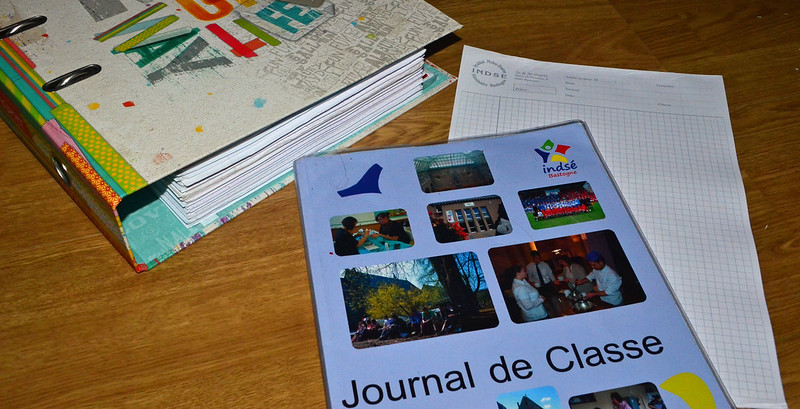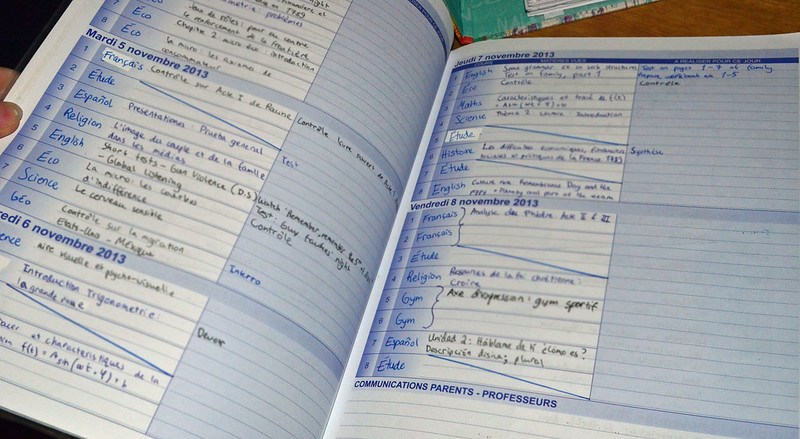- Kouluvuosi on jaettu kolmeen osaan: koulun alusta jouluun, joulusta pääsiäiseen, pääsiäisestä koulun loppuun. Jokaisen "trimestren" aikana tehdään monia pikkukokeita tai "contôles", auttamaan oppilasta varautumaan niihin suuriin kokeisiin siinä lopussa, jotka esiintyvät koeviikkona.
- Maanantaisin, tiistaisin, torstaisin ja perjantaisin, koulupäivät kestävät aina kello 8:15:sta 16:05:een. Tunnit kestävät 50 minuuttia ja kahden ensimmäisen tunnin jälkeen on kymmenen minuutin välitunti, sitten on taas kaksi tuntia, jonka jälkeen on 50 minuutin kestävä ruokailu tai keskiviikkoisin koulupäivä loppuu siihen. Muina päivinä ruokailun jälkeen on taas kaksi tuntia, sitten kymmenen minuutin välkkä ja taas kaksi tuntia.
- Vapaat tunnit (tai hypärit)täällä kulkevat nimellä "étude". Jos sinulla on étude-tunteja koulupäivän päätteeksi tai aluksi ja huoltajasi ovat antaneet kirjallisen luvan, sinun ei tarvitse olla koulussa. Jos kuitenkin étude-tunteja on keskellä päivää, kaikki paitsi viimeisellä vuodellaan olevat, joutuvat menemään suuren saliin työskentelemään haluamansa aineen parissa.
- Ilmaista kouluruokaa ei ole, mutta keittiöllä on monia vaihtoehtoja tarjottavana.Viimeisillä kahdella luokka-asteilla olevat saavat käydä koulun ulkopuolelta hakemassa ruokaa. Monet kuitenkin tuovat jonkinlaiset leivät mukanaan kotoa.
- Täällä kaikilla on omat luokkansa, jotka perustuvat niihin valintoihin mitä on aineistaan tehnyt.
- Kouluni tarjoaa neljä eri linjaa, joista en ymmärrä kuin sen missä olen, eli ns. yleinen linja. Tällä linjalla on pakollista: 2 tuntia uskontoa viikossa, 4 tuntia ranskaa, 2 tuntia maantietoa, 2 tuntia liikuntaa ja 4 tuntia joko englantia tai hollantia. Sitten menee monimutkaisemmaksi, joten otan kouluni (INDSE Bastogne) sivuilta taulukon (jota vähän muokkasin), josta ehkä ymmärrätte paremmin kuin selityksistäni. Esimerkkinä kuitenkin ensimmäinen vaihtoehto. Jos otat 6 tuntia matikkaa, saat 2 tuntia historiaa, joko 3 tai 6 tuntia tieteitä ja valinnan perusteella määrittyy loput. Eli aloitetaan ylhäältä ja jatketaan alas eri valintoja tehden ja siihen perustuu minun kouluni yleisen linjan oppiaineet.
- Itselläni on 4 tuntia matikkaa, 2 tuntia historiaa, 3 tuntia tieteitä, 4 tuntia taloustietoa ja kaksi tuntia espanjaa. Toista modernia kieltä en ottanut, koska mikään muu kuin englanti ei minulta oikein luonnistu (muut kun ovat hollantia lukeneet jo pari vuotta).
- Englanti ei siis ole pakollinen aine koulussa. Joten sitä harva täällä puhuu.
Religion/Uskonto
|
2
|
|||||||||
Français/Ranska/French
|
4
|
|||||||||
Géographie/Maantieto
|
2
|
|||||||||
Education physique/Liikunta
|
2
|
|||||||||
Langue moderne 1/Moderni kieli
1
(Englanti tai hollanti)/(English or Dutch) |
4
|
|||||||||
Mathématique/Matikka
|
6
|
4
|
||||||||
Histoire/Historia
|
2
|
4
|
2
|
|||||||
Sciences/Tieteet
|
6
|
6
|
3
|
3
|
3
|
3
|
3
|
6
|
||
Option de base simple :
Grec /Kreikka/Greek ou Latin / Latina ou Sciences sociales / Yhteiskuntaoppi/Social studies ou Sciences économiques / Taloustieto/Economics |
-
|
4
|
4
|
4
|
4
|
4
|
4
|
4
|
||
Option de base :
Langue moderne 2/ Moderni kieli 2
(English/Dutch/German)/
(Englanti/Hollanti/Saksa)
|
-
|
4
|
4
|
4
|
||||||
Activité
complémentaire : Informatique/ IT
|
(2)
|
-
|
(2)
|
-
|
(2)
|
-
|
(2)
|
-
|
||
Activité
complémentaire : Espagnol/Espanja/Spanish
|
-
|
|||||||||
- |
-
|
-
|
||||||||
Activité
complémentaire : mathématique/Extra matikka
|
(1)
|
|||||||||
 |
| Kansiossa on kaikki tämän kolmen kuukauden aikana saamani tuntiaineistot; "journal de classe"; alapuolella näkyy myös "feuille en-tête" |
-The school year is divided into three parts: from the beginning of school until Christmas, from Christmas to Easter, and from Easter to the end of the year. During these "trimestres", we do multiple little tests or "contrôles" to help the student to get ready for the actual exams at the end of the period that take the form of an exam week.
- On Mondays, Tuesdays, Thursdays, and Fridays, the school days always last from 8:15 to 16:05. The lessons last 50 minutes and after the first two, there's a recess of ten minutes, then another two lessons after which you have a 50 minute lunch break or on Wednesdays, your school day ends. For the other days, after lunch you have another two lessons, a ten minute break and another two lessons.
- There is no free school food, but the kitchen has many different options to offer. The students on the last two grades are allowed to go get some food outside of the school. Many people however bring some sort of sandwiches from home.
- Free hours, or skips, go with the name "étude" here. If you have étude-hours at the end of your school day or at the beginning and your guardians have given a written permission, you don't have to be at school. If however, you have étude-lessons in the middle of your day and you're not doing your last year at school, you have to go to a huge hall to work on a subject of your choice.
- Here everyone has their own class, which is based on the choices you've made concerning your subjects.
- My school offers 4 different sections out of which I only understand the one I'm in: the so-called general section. In this section, the following are obligatory: 2 hours of religion a week, 4 hours of french, 2 hours of geography, 2 hours of P.E. and 4 hours of either english or dutch. Then it gets a little more complicated, so I'm taking a table from the site of my school (INDSE Bastogne) (which I edited a little to make it more clear) and putting it above so you'll understand a little better than through my explanations. As an example, I'll just take the first option. So if you take 6 hours of math (these are always per week), you get 2 hours of history, either 3 or 6 hours of sciences and based on your choice, the rest of it is defined. So you start from the top and continue downwards making different choices and that's what this section is based on.
- Personally I have 4 hours of math, 2 hours of history, 3 hours of sciences, 4 hours of economics and 2 hours of spanish. I didn't take a second modern language because I can only manage english (while others have been studying dutch for a couple of years already).
- My school offers 4 different sections out of which I only understand the one I'm in: the so-called general section. In this section, the following are obligatory: 2 hours of religion a week, 4 hours of french, 2 hours of geography, 2 hours of P.E. and 4 hours of either english or dutch. Then it gets a little more complicated, so I'm taking a table from the site of my school (INDSE Bastogne) (which I edited a little to make it more clear) and putting it above so you'll understand a little better than through my explanations. As an example, I'll just take the first option. So if you take 6 hours of math (these are always per week), you get 2 hours of history, either 3 or 6 hours of sciences and based on your choice, the rest of it is defined. So you start from the top and continue downwards making different choices and that's what this section is based on.
- Personally I have 4 hours of math, 2 hours of history, 3 hours of sciences, 4 hours of economics and 2 hours of spanish. I didn't take a second modern language because I can only manage english (while others have been studying dutch for a couple of years already).
- So in fact, English is not an obligatory subject at school so just a few people here actually speak it.


Ei kommentteja:
Lähetä kommentti